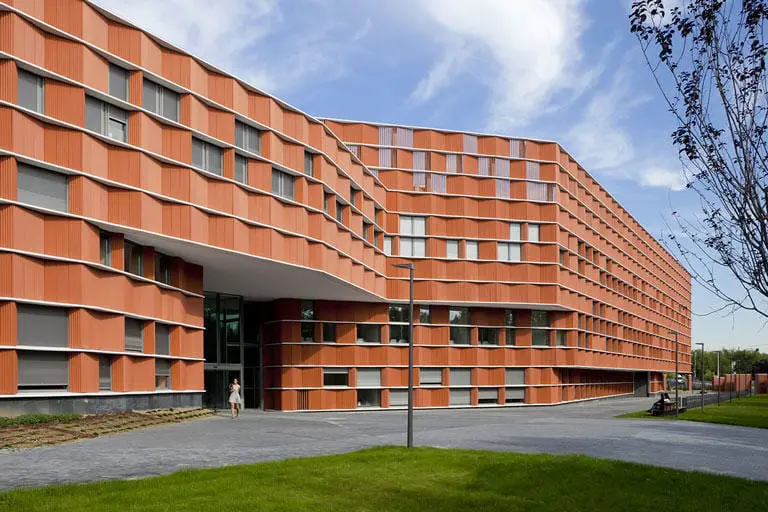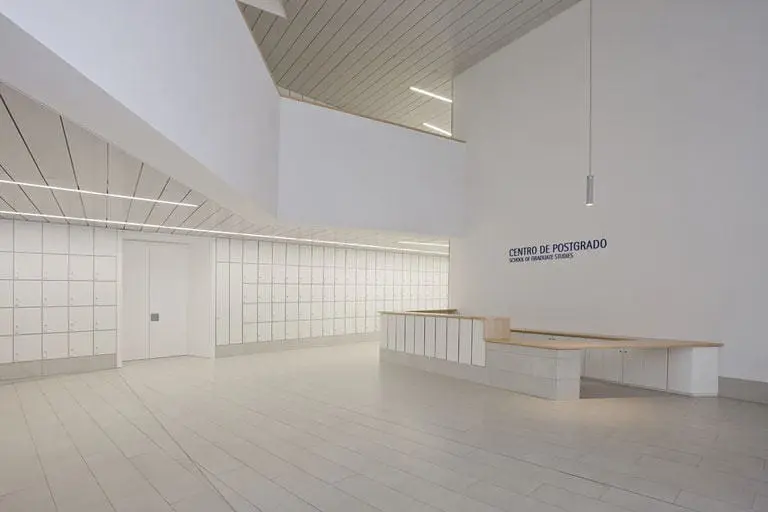Our arrangement, winner of the urban planning contest, lays the extension buildings on both sides of a linear park that organizes the pedestrian traffic of the campus. This first one settles the front of Madrid Street, connecting itself by means of a walkway to the building already standing on the plot and making it possible to cross the building in its central part through a big foyer that connects the new park with the rest of the campus. Two storeys are organized on each side of this foyer, the Humanities library on one side and the lecture rooms on the side that is closer to the pre-existing lecture hall building. Over these, the departmental zone is organized on one storey.
The building design is sustained on our engagement with innovation and sustainability, as well as on our conviction that these two go hand in hand. On the one hand, as opposed to an educational architecture that is traditionally rigid, systematic and repetitive, we take sides for a flexible, diverse and humanized architecture. An architecture tending less to be a reflection of the institution’s authority and more attentive to provide services to teachers and students, creating spaces for diverse encounters where a great number of new models of learning and research can be accommodated. On the other hand, the whole building responds to the growing commitment of all the parties towards the environmental sustainability. During the project and construction phases, countless sustainability measures have been incorporated, with the result that a degree of excellence has been achieved that had not been reached in Spain until now by an educational centre. It will be the first one of its kind to obtain a LEED Certificate and it will be in the highest grade: PLATINE LEED.
The process of conceiving the building has constituted a deliberate pendular movement between the confidence in the system and the repetition, on the one hand, and the search for exception and diversity on the other hand. System and repetition, on their own, provide a reassuring coherence and an economy of means, at the same time as they offer an intense flexibility. On the other hand, exception and diversity humanize architecture and make the user free to choose among multiple possibilities of use, which awards him a leading role. Thus, the bays repeat a well-studied modulation that solves with efficacy the division into big or small lecture rooms and offices. However, these bays bend looking for visual effects, adapting themselves to the surrounding spaces and enhancing the communication spaces.
The extensive use of few materials in all the building is explored up to their last possibilities, requiring qualities that will allow them to respond in an attractive and effective manner to very different situations. Two ceramic materials are a fundamental part of this building’s architecture. In a campus of buildings made of white concrete and exposed bricks, a façade has been chosen that reproduces these two materials reinterpreting them in sustainability terms. Between elongated bands of decontaminating precast concrete that project shade on the façades in summer, a ceramic skin has been extended having the same colour as that of the exposed bricks of the adjacent buildings.
Ceramic piece. Façade is composed of extruded fired clay pieces that form a ventilated façade having an extraordinary thermal efficacy that, at the same time, conceals the structure between the geometry of its folds. The repetition of a same piece extended to 6.800 m2 of façade made it possible to design the geometry of the piece and its fluting, creating a façade of vibrant texture. On the upper part of the building, the façade becomes a lattice that conceals the roof installations allowing these spaces to be ventilated. To this end, some modules are substituted by lattices made up of baguettes of the same material, continuing the irregular texture given to the façades by the window scattering.
Tile of Spain Awards ASCER 2013. Finalist Architecture category



























